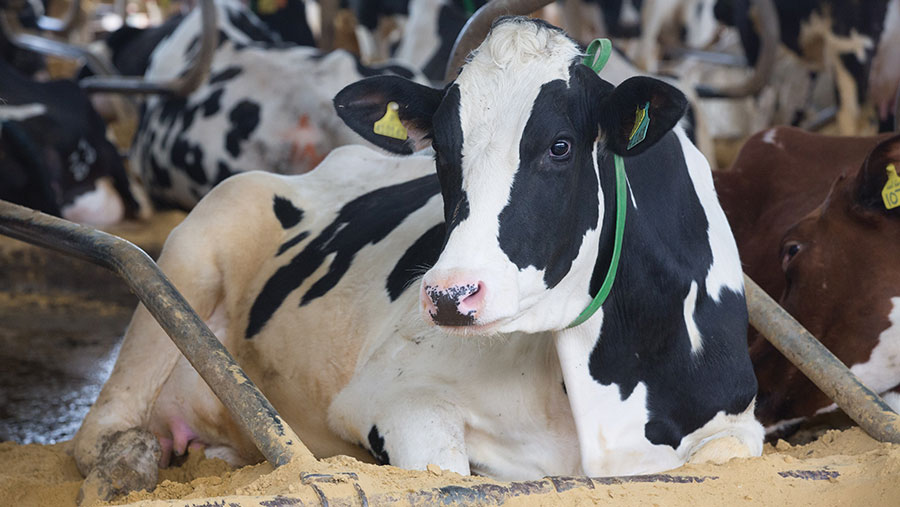5 ways to fine-tune cubicle housing for udder health
 © Tim Scrivener
© Tim Scrivener Summer is a good time to review milking cow accommodation. For year-round housed cows, this can be the period of highest environmental infection pressure.
For seasonally housed herds, summer is an opportunity to make changes to buildings while they are empty.
See also: 5 ways to improve udder health with dry period management
The following aspects of building design often get overlooked:
1. Muck and moisture
Bacteria grow best in warm, wet organic matter, so the basic tactic to reduce environmental mastitis risk is to maintain a clean, dry, cool environment.
However, the devil is in the detail, requiring focus on specific areas to check that the environment really is as hygienic as it appears.
- Cows may look clean, but if their feet are dirty, this causes direct contamination of the teat skin when they lie down. Aim for less than 15% of the herd with dirty feet and legs.
- Passageways that look clean can have hidden limitations. Waves of slurry generated by automatic scrapers lead to dirty feet and legs, despite leaving the passage surface clean. Not scraping flush with the cubicle kerb leaves a thin strip of slurry that splashes teats when cows step out of the beds.
- Bedding may appear clean yet still have a high bacterial content if mattresses (or lower layers of deep beds) are dirty, causing visually clean teats to still have high bacterial load.
- Pooling of contaminated water increases building humidity, as well as providing a splash risk for teats.
2. Stocking rates
Stocking rate targets are a useful guide, but they do not cater for numerous variables that can change over time.
Plan stocking rates to account for the worst-case scenario of bacterial challenge.
- Higher yields result in higher volumes of slurry output. An extra two litres of milk a cow will increase slurry production by about 1.2kg a cow a day.
- Greater social activity increases the risk of splashing teats with slurry. This commonly occurs when mixing new cows into a group, or housing numerous bulling cows together when using synchronisation programmes.
- High temperature and humidity increase bacterial growth rates. Stocking rates that were previously suitable may now lead to unacceptable levels of bacteria.
3. Passage cleanliness to reduce contamination
Foot and leg cleanliness is vital to reduce bacterial challenge to the teat when cows lie down. Contamination may come from many sources, with passage hygiene a particular challenge.
- Passages in three-row pens have 150% of the cow traffic of the equivalent two-row pens, so dimensions need to be correspondingly greater to account for increased slurry deposits.
- Passage layout has a large effect on cow hygiene. Bottlenecks increase bullying, leading to more slurry splashing on limbs and udders.
- Additional loafing areas can reduce passage contamination, but incentives such as additional feed troughs may be needed to encourage use of these spaces.
- Different cleaning methods have different limitations: tractor scraping is often too infrequent; blade scrapers can create large slurry waves; flood washing presents a splash risk; robotic vacuum cleaners can be unreliable. Adapt management strategies to account for each system’s specific challenges.
4. Cubicle design and bedding maintenance
With good cubicle design and appropriate bedding management, there is no need to compromise comfort or hygiene.
- Cubicle soiling is a useful guide: if more than 10% of beds are soiled, it suggests cubicle dimensions are adversely affecting lying position. However, much less than 10% may indicate poor cow comfort.
- Lying position is crucial to reduce cows dunging on the bed. Bed length should allow cows to lie with their hock well supported, and with their tail head overhanging the passage. Rather than relying on standard recommended bed lengths, position the brisket locator to suit your cow size.
- Standing position is also critical to maintain clean beds. On mattresses, a little faecal contamination can be tolerated, so the neck rail should allow cows to stand with their back feet just on the mat.
- For deep beds, contamination is a bigger problem; neck rail position should ensure cows step out of the cubicle after rising (the increased stress on claw horn is balanced by greater lying times).
- Bedding frequency recommendations vary depending on bedding type, but the best results come from being adaptable. Increase frequency during periods of high bacterial challenge.
- For deep-bedded cubicles, occasional removal of the rear portion of bedding may be required.
5. Ventilation to limit bacterial growth
Dry air helps maintain dry bedding, making conditions less favourable for bacterial growth.
The total volume of air within the building should be regularly replaced with external air to reduce humidity, pathogens, and concentration of gases like ammonia.
- Few buildings achieve the recommended number of air changes/hour (ACH). Targets vary with season and climate, but in summer they should be at least 40 ACH. This is largely due to reliance on natural ventilation, which is rarely sufficient.
- Using smoke bombs in a building can show how many air changes/hour are achieved and highlights air flow pathways and dead spots.
- Mechanical ventilation requires careful design to deliver results. Fans can ventilate buildings, recirculate air to avoid stale spots or cool cows, but one single fan system is unlikely to achieve all three roles.

